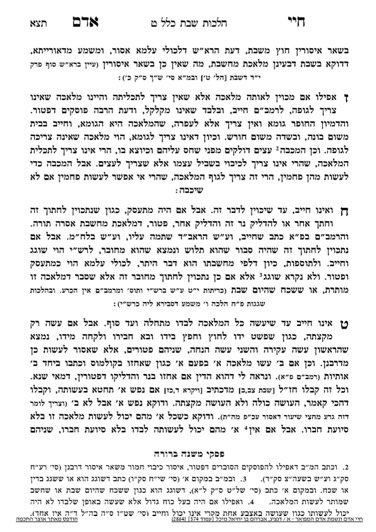We are continuing in siman 7, discussing the concept of melacha she’tzricha legufa and melacha she’eina tzricha legufa. The Chayei Adam gave an example of one who digs a hole for the purpose of the dirt rather than for the purpose of the hole.
The Chayei Adam gives another example of one who extinguishes burning wood because he wants to save the wood. We have to understand that kibui, extinguishing, is one of the 39 melachos, but kibui is almost always to prevent something else from happening (e.g., further destruction), so definitionally it would seem to be a melacha she’eina tzricha legufa. The kibui is not inherently necessary inasmuch as the purpose is the saving of the item which would otherwise be destroyed. In this case of saving the wood, the Chayei Adam writes that the kibui is a melacha she’eina tzricha legufa.
When it comes to kibui, a case of melecha she’tzricha legufa would be if one burns wood for the purpose of creating charcoal. Charcoal makes a much more controlled fire, because once it is singed the first time, it is easier to control the fire the second time. Artisans who smelt metal and similar items would use these “pre-singed” pieces of wood for their work. Thus, extinguishing the fire to create the singed wood is an intrinsic part of the process of making charcoal, and is therefore a melecha she’tzricha legufa, because it is inherently needed for the situation.
These examples help us understand how to define the primary purpose of a melacha, which, in turn, defines whether an action is a melacha she’tzricha legufa or she’eina tzricha legufa. Tosfos suggests that the primary purpose of a melacha is learned from the mishkan. We look at the mishkan and define the primary purpose of a melacha, and once we identify it, that is considered its primary purpose and defines tzricha legufa. Any other purposes are considered eina tzricha legufa.
Tosfos is responding to Rashi, who gives a different definition. Rashi explains that there are certain melachos done in a situation which a person would prefer does not exist, but once they exist, one tries to extricate themselves from the situation as quickly as they can. This type of situation is considered she’eina tzricha legufa. For example, if a fire is burning down a house and one extinguishes the fire, it is considered eina tzricha legufa because one would prefer that there was no fire to begin with. On the other hand, the case of making singed wood is something that the person actively wants, and therefore is considered tzricha legufa.
Tosfos has many questions on Rashi. Either way, according to Tosfos, even though kibui primarily existed in the mishkan when they put out the fires under the items which they were cooking, such kibui is a safety issue to prevent burning things down and as such, it was not part of building the mishkan. Rather, the only kibui which was part of meleches hamishkan, was that they would create singed wood for the purpose of more controlled fires, which we then used in making dyes, etc. this now becomes the definition of kibui which is assur as a melacha. However, according to Rashi, it is not necessary to go back and define which kibui was a part of meleches hamishkan and which not. Rather, it only depends on one’s attitude towards the melacha right now, so if extinguishing is part of the process of cooking a wanted item, it would be considered tzricha legufa, and if not, not.
Summary
- Melacha she’eina tzricha legufa is a melacha performed with the proper intent for the action, but with intention for a different outcome than the melacha’s normal primary outcome. Therefore, the majority of poskim hold it is not assur mideoraysa, because it is lacking in meleches machsheves, but rather assur miderabanan.
- According to Rashi, tzricha legufa is defined as the outcome which a person actively wants, while eina tzricha legufa refers to melacha performed in order to extricate oneself from an unwanted situation.
- According to Tosfos, tzricha legufa is defined as the primary performance of the melacha in the mishkan, and any other performance of the melacha is eina tzricha legufa.



